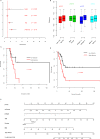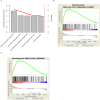Risk score based on three mRNA expression predicts the survival of bladder cancer
- PMID: 28977887
- PMCID: PMC5617447
- DOI: 10.18632/oncotarget.18642
Risk score based on three mRNA expression predicts the survival of bladder cancer
Abstract
Bladder cancer (BLCA) is one of the most malignant cancers worldwide, and its prognosis varies. 1214 BLCA samples in five different datasets and 2 platforms were enrolled in this study. By utilizing the gene expression in The Cancer Genome Atlas (TCGA) dataset, and another two datasets, in GSE13507 and GSE31684, we constructed a risk score staging system with Cox multivariate regression to evaluate predict the outcome of BLCA patients. Three genes consist of RCOR1, ST3GAL5, and COL10A1 were used to predict the survival of BLCA patients. The patients with low risk score have a better survival rate than those with high risk score, significantly. The survival profiles of another two datasets (GSE13507 and GSE31684), which were used for candidate gene selection, were similar as the training dataset (TCGA). Furthermore, survival prediction effect of risk score staging system in another 2 independent datasets, GSE40875 and E-TABM-4321, were also validated. Compared with other clinical observations, and the risk score performs better in evaluating the survival of BLCA patients. Moreover, the correlation between radiation were also evaluated, and we found that patients have a poor survival in high risk group, regardless of radiation. Gene Set Enrichment Analysis was also implemented to find the difference between high-risk and low-risk groups on biological pathways, and focal adhesion and JAK signaling pathway were significantly enriched. In summary, we developed a risk staging model for BLCA patients with three gene expression. The model is independent from and performs better than other clinical information.
Keywords: bladder cancer; expression; prognosis.
Conflict of interest statement
CONFLICTS OF INTEREST The authors declare no (potential) conflicts of interest.
Figures




Similar articles
-
Prediction of Prognosis and Recurrence of Bladder Cancer by ECM-Related Genes.J Immunol Res. 2022 Apr 12;2022:1793005. doi: 10.1155/2022/1793005. eCollection 2022. J Immunol Res. 2022. PMID: 35450397 Free PMC article.
-
A risk score staging system based on the expression of seven genes predicts the outcome of bladder cancer.Oncol Lett. 2018 Aug;16(2):2091-2096. doi: 10.3892/ol.2018.8904. Epub 2018 Jun 5. Oncol Lett. 2018. PMID: 30008905 Free PMC article.
-
Prognostic Signature of Alternative Splicing Events in Bladder Urothelial Carcinoma Based on Spliceseq Data from 317 Cases.Cell Physiol Biochem. 2018;48(3):1355-1368. doi: 10.1159/000492094. Epub 2018 Jul 26. Cell Physiol Biochem. 2018. PMID: 30048970
-
An RNA-sequencing-based transcriptome for a significantly prognostic novel driver signature identification in bladder urothelial carcinoma.PeerJ. 2020 Jul 21;8:e9422. doi: 10.7717/peerj.9422. eCollection 2020. PeerJ. 2020. PMID: 32742772 Free PMC article.
-
Risk score based on ten lncRNA-mRNA expression predicts the survival of stage II-III colorectal carcinoma.PLoS One. 2017 Aug 10;12(8):e0182908. doi: 10.1371/journal.pone.0182908. eCollection 2017. PLoS One. 2017. PMID: 28796819 Free PMC article.
Cited by
-
A radiogenomics signature for predicting the clinical outcome of bladder urothelial carcinoma.Eur Radiol. 2020 Jan;30(1):547-557. doi: 10.1007/s00330-019-06371-w. Epub 2019 Aug 8. Eur Radiol. 2020. PMID: 31396730
-
31 gene expression-based signatures serve as indicators of prognosis for patients with glioma.Oncol Lett. 2019 Jul;18(1):291-297. doi: 10.3892/ol.2019.10327. Epub 2019 May 7. Oncol Lett. 2019. PMID: 31289499 Free PMC article.
-
Transcriptomic model-based lncRNAs and mRNAs serve as independent prognostic indicators in head and neck squamous cell carcinoma.Oncol Lett. 2019 Jun;17(6):5536-5544. doi: 10.3892/ol.2019.10213. Epub 2019 Apr 4. Oncol Lett. 2019. PMID: 31186775 Free PMC article.
-
Plasma COL10A1 Level, a Potential Diagnostic and Prognostic Biomarker for Pancreatic Ductal Adenocarcinoma.Onco Targets Ther. 2024 Nov 6;17:949-959. doi: 10.2147/OTT.S474540. eCollection 2024. Onco Targets Ther. 2024. PMID: 39525356 Free PMC article.
-
Identification of a Seven-Differentially Expressed Gene-Based Recurrence-Free Survival Model for Melanoma Patients.Dis Markers. 2022 Jul 14;2022:3915112. doi: 10.1155/2022/3915112. eCollection 2022. Dis Markers. 2022. PMID: 35872694 Free PMC article.
References
LinkOut - more resources
Full Text Sources
Other Literature Sources

